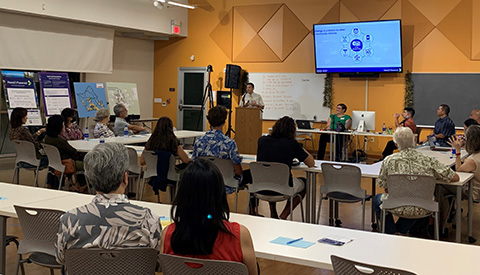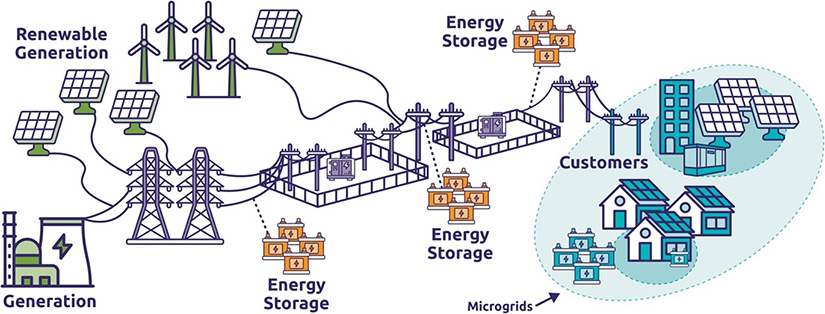Sign up for daily news updates from CleanTechnica by email. Or Follow us on Google News!
At the National Renewable Energy Laboratory (NREL), researchers often act as guides, helping communities navigate the world of renewable energy solutions. But in community-based technical assistance projects, the mentoring role works both ways: researchers need local perspectives to fill contextual knowledge gaps and create more meaningful energy solutions.
“Energy problems are people problems. We prioritize people’s interests and develop tools to serve them,” said Katy Waechter, an NREL researcher whose people-focused lens helped her team make critical adjustments during an energy resilience project for the island of Oahu in Hawaii.

For six weeks, Waechter, along with representatives from the utility Hawaiian Electric and the Hawaii Natural Energy Institute, affiliated with the University of Hawaii, traveled the 600-square-mile island to hear from individuals about independent ownership of hybrid microgrids. No amount of preliminary research could have prepared the team for what they discovered: genuine concerns, fresh perspectives, and previously unknown priorities that ultimately changed the team’s research direction to better inform energy planning for all of Oahu.
Oahu was one of the first eleven communities in the United States to join the U.S. Department of Energy Partnership Project under the Energy Transition Initiative (ETIPP)a technical assistance program for community-driven energy resilience projects that combines the local knowledge of regional organizations with the expertise of national laboratory researchers. Each ETIPP project is shaped by the priorities and nuances of a community, including elements such as energy resources, cultural heritage, socioeconomic factors, and resilience goals. The technical assistance in Oahu illustrated how researchers, when they follow the lead of residents rather than using one-size-fits-all approaches, can help facilitate energy planning that best meets local long-term needs.
Hybrid microgrids explored as a solution to Oahu power outages
Some Oahu residents live in isolated communities with limited electrical infrastructure and wait weeks for power to be restored after extreme weather events. Local utility Hawaiian Electric applied to ETIPP with the vision of bringing hybrid microgrids to the island to help alleviate extended power outages.
Hawaiian Electric hoped that the discussions about microgrid deployment would play an important role in the energy planning conversation on Oahu about achieving 100% renewable energy by 2045, particularly how to fairly distribute the benefits and burdens of the transition.
“Ensuring the transition to renewable energy happens in a fair way is something that many utilities and partners recognize needs to happen, and ETIPP is designed to encourage that co-creation process with the community,” said Kurt Tsue, Hawaiian Electric’s director of community affairs, who worked on the ETIPP project.

With support from ETIPP researchers at NREL and Sandia National Laboratories, Hawaiian Electric planned to evaluate optimal hybrid microgrid locations to improve the resiliency of Oahu’s electrical infrastructure. Unlike traditional microgrids, which are installed and operated by utilities, hybrid microgrids in Hawaii are independently developed and operated, meaning residents must petition to develop them. But hybrid microgrids are a new service on Oahu, so many residents don’t yet know they’re an option. The ETIPP team wanted to “help communities learn more about hybrid microgrids, how they work, and decide if it’s a solution for them,” Waechter said.
“We were working purely on designing something with the community and not coming at it with any preconceived ideas about wanting to build something,” Tsue said.

During one of the first meetings the ETIPP research team held with a group of Oahu residents to discuss microgrid options, they found that many resident questions still needed to be answered before they could discuss potential locations or participants for hybrid microgrids.
“It quickly became apparent that the concerns of the communities were not necessarily being addressed by what we were trying to discuss with them,” Waechter said. “So we had to shift the conversation to how hybrid microgrids could address their concerns about energy reliability and security.
Community members also indicated that they would like to see more diverse representation from the five different Oahu islands. ship (districts) – 'Ewa, O'ahu, Ko'olauloa, Ko'olaopoko and Wai'anae – in island-wide energy planning conversations.
“We have our largest Native Hawaiian population on the west side, which has seen more of the transition to renewable energy because the resource potential and the availability of land is much greater there,” Tsue said. “People on the west side wonder why everything has to be put there. They think that [the renewable energy transition] is carried on their backs.”
Speaking Up: Listening to What Matters Most to Oahu Residents

NREL researchers worked with Hawaiian Electric, the Hawaii Natural Energy Institute, and the Hawaii Emergency Management Agency to create a community engagement strategy that addressed these concerns. The ETIPP team held five meetings, one for each of Oahu’s regions, to allow for greater participation. Live broadcasts of the meetings included feedback options via Zoom and social media channels. The team also posted recordings of the meetings on Hawaiian Electric’s website, giving residents the opportunity to submit comments on their own time.
While the research team knew which types of facilities would typically be prioritized for inclusion in microgrid coverage, such as hospitals and emergency services, they instead asked each regional community to indicate which buildings and services they believed were priority.
“That was my favorite part: learning about the places that are important to these communities,” Waechter said. “That knowledge changed what we were mapping and changed what these hybrid microgrid capabilities could potentially cover.”
Some of the priority sites included veterans centers, commercial kitchens, sewage pumps and a remote dam that serves as a local gathering point during major weather events like tsunamis and hurricanes. Tsue said it was “extremely valuable” to document feedback from community members about places that were important to them.
“We asked about things like resilience hubs or meeting places that are meaningful to communities, things we didn't have insight into yet,” Tsue said.
To address the logistical challenges of participation, reach a broader audience, and share resources, ETIPP researchers combined their hybrid microgrid information sessions with Hawaiian Electric integrated grid planning meetings and other community organization meetings.
“By coupling these microgrid discussions with some of the other renewable energy plans we were already doing, it became even more valuable. It led to really meaningful discussions in the community,” Tsue said.
All of the community input informed the data collection process that ETIPP researchers used to create a series of maps showing different types of hybrid microgrid options in each community, and across the island. Whether a hybrid microgrid was considered appropriate for a particular area was based on current electricity distribution and community needs, and whether it would provide enhanced support for critical services and lifelines, improved service reliability for vulnerable grid infrastructure, and equitable access to microgrid services.

Hawaiian Electric plans to use these materials to further reach the community and expand its microgrid analysis to the other Hawaiian Islands in its service area.
One of the community leaders who participated in Hawaiian Electric’s ETIPP project was inspired to apply to ETIPP the following year to receive support for a specific resilience hub. Hui o Hauʻula, a community-based organization on Oahu’s East Shore, was accepted into ETIPP in 2022 and is coordinating the planning and development of a community resilience hub that will generate and store power before, during, and after a disaster or outage for the surrounding Koʻolauloa District.
“ETIPP is a truly unique opportunity to empower communities to make their own decisions,” said Tsue.
Waechter agreed.
“The work is ultimately about serving communities by giving them a data-driven foundation to make decisions,” she said. “It all comes down to what people care about. The different types of analytics that we do to help people answer questions about their own energy autonomy, it's really heartening to be able to do that.”
ETIPP is managed by NREL and funded and supported by the U.S. Department of Energy's Office of Energy Efficiency and Renewable Energy.
EL and funded and supported by the U.S. Department of Energy's Office of Energy Efficiency and Renewable Energy
By Brooke Van Zandt | Thanks to NREL.
Do you have a tip for CleanTechnica? Want to advertise? Want to suggest a guest for our CleanTech Talk podcast? Contact us here.
Latest CleanTechnica.TV Videos
CleanTechnica uses affiliate links. See our policy here.

